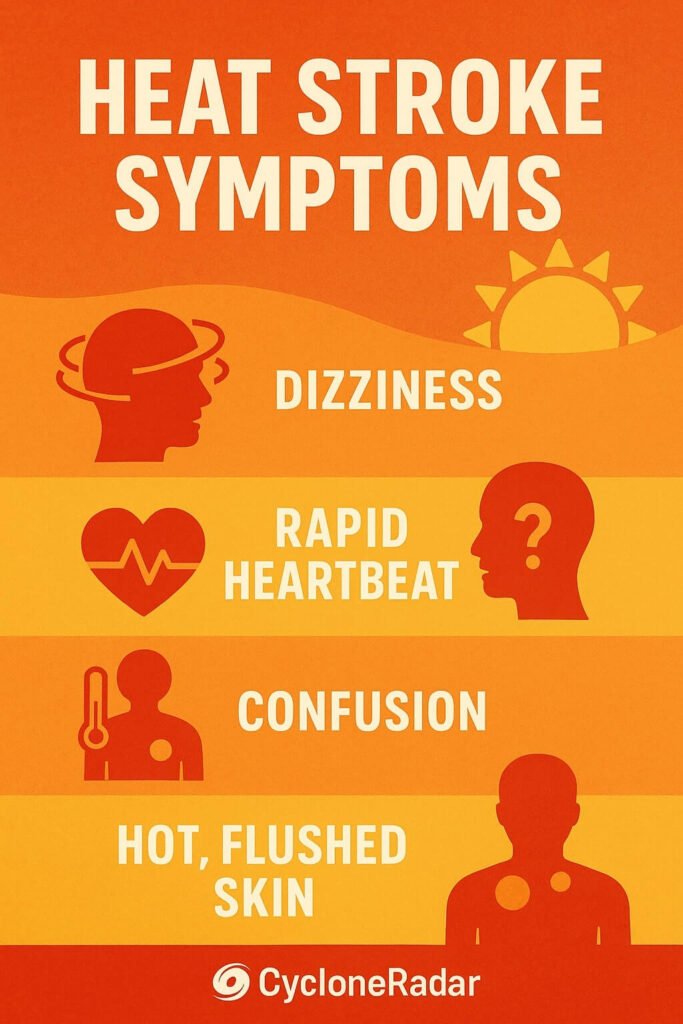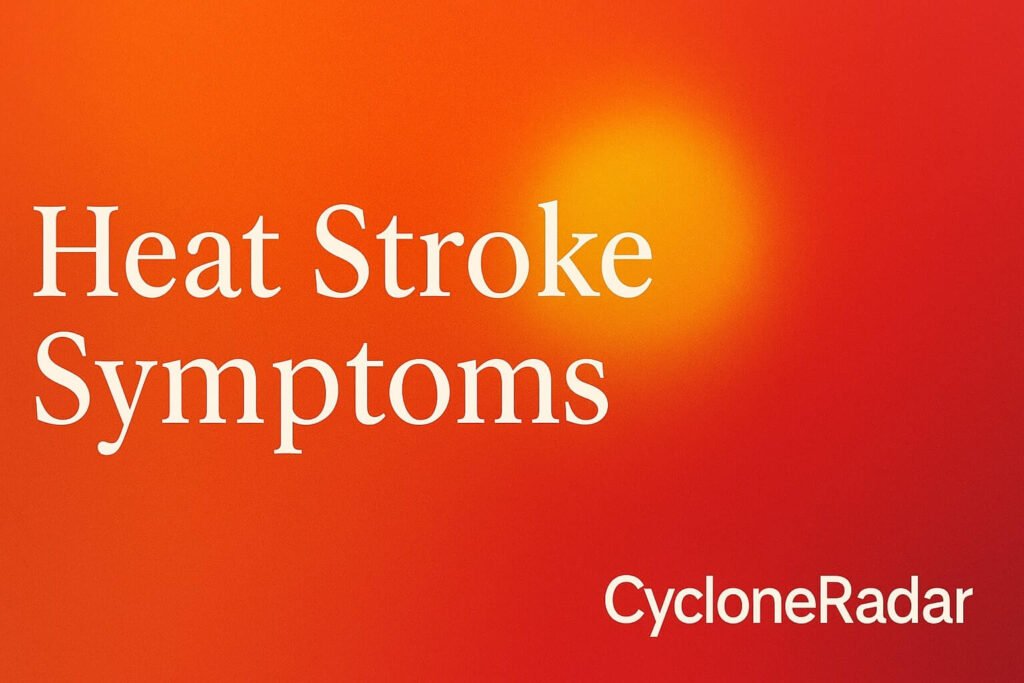Heat stroke symptoms don’t start with drama. They whisper at first, like a subtle shift in how the heat feels on your skin, a headache that sneaks in behind your eyes, or a strange confusion about why you’re feeling so off. Yet what begins as dizziness or a pounding heart can escalate rapidly into a full-blown medical crisis. Across the U.S., especially during extreme heatwaves, heat stroke has become one of the most urgent weather-related health risks. If you live in a region where summer gets ruthless, or you’re preparing for a heatwave season tied to climate events like El Niño or hurricanes, understanding heat stroke symptoms could literally save a life.
At CycloneRadar, we often talk about storm alerts, evacuation kits, and hurricane shutters. But this is a silent emergency, one that doesn’t knock down your door with 120 mph winds, but instead creeps in through sweltering heat and forgotten hydration. Whether you’re on a disaster preparedness team, part of a rescue service, or simply someone looking after family in a hot zone, learning to read the body’s heat signals is crucial.
Let’s break it down in a way that feels real, grounded, and easy to remember.
When Your Body Starts to Break the Rules: Recognizing Heat Stroke Symptoms
Heat stroke is the most severe form of heat illness. It happens when your core body temperature rises to 104°F (40°C) or higher, and the body’s internal cooling system fails. This can damage the brain, heart, kidneys, and muscles—sometimes permanently. The progression can be shockingly fast.
At first, it may feel like you’re just a little dehydrated or sunburned, but the symptoms become more intense as the internal systems shut down. Most experts divide heat stroke symptoms into early and late stages, but in reality, these signs often overlap or emerge suddenly. What matters most is noticing them as a group, and not brushing them off.
Early symptoms include:
- A rapid heartbeat that feels harder than it should be
- A severe headache or dizziness that doesn’t go away with rest
- Nausea, sometimes with vomiting
- Excessive sweating—or, in some cases, your skin suddenly becoming dry
- Muscle cramps, especially in the legs or abdomen
You might think it’s just heat exhaustion at this point, but the switch to heat stroke can be frighteningly fast.
Critical red-flag symptoms:
- Confusion, slurred speech, or an inability to answer simple questions
- Sudden irrational behavior or irritability
- Seizures or unconsciousness
- Hot, flushed skin that may feel dry even in extreme heat
- A body temperature of 104°F or higher if measured rectally
The moment mental changes appear, you’re no longer in the safe zone. Confusion or collapse is not just a bad reaction to a hot day—it’s an emergency.
People at the highest risk are the elderly, infants, outdoor workers, athletes training in the heat, and those with chronic illnesses like heart disease or diabetes. However, healthy individuals are not exempt. During heat waves linked to climate shifts or post-storm humidity surges, even a short time in direct sun can be enough to trigger heat stroke symptoms.
What To Do When Heat Stroke Hits
Responding to heat stroke is all about speed. Every minute counts. If you suspect someone is experiencing heat stroke symptoms, call emergency services immediately. Do not assume they’ll “sweat it out” or recover with a cold drink.
Here’s what you can do while waiting for help:
- Move them into shade or an air-conditioned environment
- Remove excess clothing to help with ventilation
- Apply cold compresses to the neck, armpits, groin, and back—these are the fastest paths to core cooling
- If safe and possible, immerse the person in cold water or use a hose or shower
- Do not give fluids if the person is confused or semi-conscious—they could choke
Some first responders now carry ice tubs to athletic events or outdoor job sites for this very reason. Cooling someone to below 102°F as fast as possible can reduce the risk of long-term organ damage.
Unlike many other weather-related conditions we monitor at CycloneRadar, heat stroke doesn’t come with thunder or radar signatures. It comes quietly, often indoors or in a parked car, sometimes hours after the worst of the heat has passed. That’s why prevention, awareness, and a quick response matter more than anything.
Why Heat Stroke Symptoms Are Rising: Climate, Urban Heat, and Unpreparedness
We’re not just seeing more heat stroke symptoms because people are working out too hard or underestimating hydration. Global data shows that heatwaves are now longer, more frequent, and more intense, particularly in hurricane-prone and urban coastal areas. Cities like Phoenix, Houston, and Miami have reported record-breaking ER visits tied to heat illness in recent years.
The urban heat island effect makes this worse. Concrete holds heat long into the night, meaning even sunset offers no relief. After hurricanes, power outages often coincide with extreme humidity, pushing indoor temperatures to dangerous levels. That’s when the most vulnerable—older adults, babies, and those with mobility issues—suffer the most.
Add to this the fact that many people don’t recognize the seriousness of early signs. Heat stroke symptoms can feel deceptively mild at first. It might just seem like a hot day. But when someone starts acting strange, or collapses out of nowhere, it’s often too late to rely on casual cooling methods.
Public health experts now compare heat waves to natural disasters in their own right. They’re pushing for emergency plans that treat heat stroke like we treat floods or windstorms—with action plans, neighborhood checks, and even government alerts. You might not hear a siren before it strikes, but it’s just as deadly if ignored.

Know the Signs, Save a Life
We talk a lot about resilience at CycloneRadar. Whether it’s boarding up windows before a hurricane, preparing your flood barrier system, or understanding storm surge zones, it always comes down to this: the more you know, the more power you have to protect your people.
Heat stroke symptoms are one of those quiet threats. They don’t make headlines like hurricanes, but they claim lives every single summer. You don’t need a degree in medicine to spot the signs—you just need to stay alert, especially when the temperature soars and the humidity chokes the air.
Teach your family what to look for. Check on your neighbors during heat waves. Carry water, wear light-colored clothes, and pace yourself during outdoor activities. Most importantly, if someone starts acting confused, gets red-hot skin, or collapses—act immediately. It might be the fastest call you ever make, but it could be the most important.
As our world heats up, awareness is just as powerful as any weather radar. Stay sharp, stay cool, and keep watching the signs.


